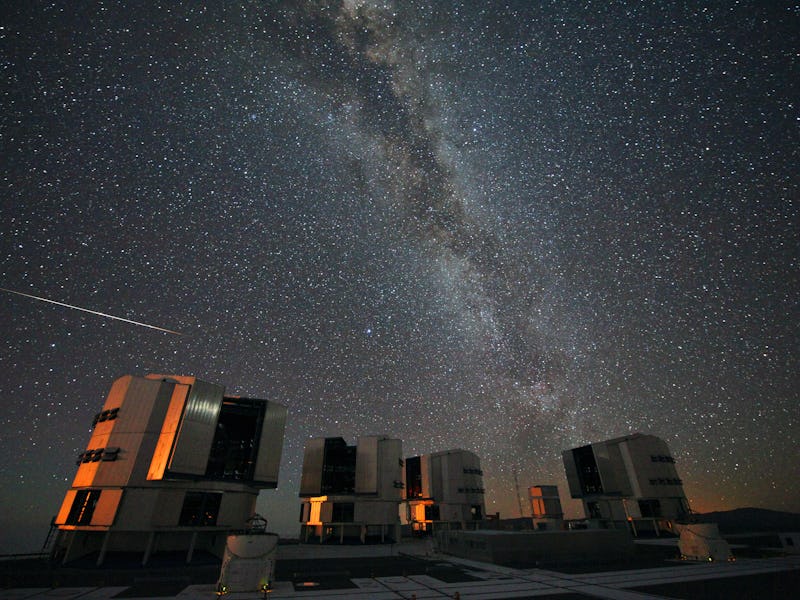How to Watch the Epic 2016 Perseid Meteor Shower
The annual meteor shower is considered one of the most active and fun to watch.

For those who take their wishing seriously, the summer Super Bowl of shooting stars will peak during the pre-dawn hours on August 12. NASA predicts that the 2016 Perseid Meteor Shower could be twice as active as previous years, and could result in a phenomenal 200 meteors lighting up the sky every hour.
That’s the word from Robert Lunsford, a lifelong amateur astronomer and treasurer for the American Meteor Society, who tells Inverse that this year’s shower “is predicted to be more active than previous years,” and puts it on the top of his list of celestial events this season.
That’s a pretty wild statement when you realize the Perseid was ignored for most of human history. Sky & Telescope points out that the hype around the Perseid — even in the astronomy community — didn’t really ignite until around 1837.
Four years earlier, humans watched as nearly 1,000 meteors per hour fell from the sky during what’s now known as the Leonids. Edward Herrick, bookstore owner-turned-amateur astronomer from New Haven, Connecticut, took notice and kept his eyes to the heavens from then on. In 1837 he observed an unusual amount of streaking lights pepper the night sky on the nights of August 9, 10, and 11.
The night the stars fell.
Herrick, the first in a long line of amateurs who’ve made an impact in the field, pored over the histories and pieced together a long record of streaking lights appearing in the early days of August throughout history. The most famous of the many references he uncovered had to do with the Feast of St. Lawrence. The Catholic feast is celebrated yearly on the anniversary of the Saint’s martyrdom: August 10, 258. Herrick found records of the tears of St. Lawrence stretching back far into European antiquity, and the Perseids were established.
Not actually the tears of a heavenly angel, this light show is the result of our planet crossing through the trail of the Swift-Tuttle comet — named for its re-discoverers Lewis Swift and Horace Parnell Tuttle. In June of 1862, they concurrently took notice of a cosmic body as bright as the North Star. Without a clear historical record to calculate a trajectory from, the comet was lost for a time.
An increase of meteoric activity in the Perseid shower in the 1970s led Brian Marsden, then the director of the Harvard-Smithsonian Center for Astrophysics, to accurately predict the year of Swift-Tuttle’s return in 1992, but the comet was 17 days late. Recalculations of its orbit were necessary. These new figures led Marsden to assert that on its next go around, in 2126, the comet would collide with Earth. This was troubling considering the size of this comet’s center is about the same as the asteroid blamed for ending the dinosaurs.
Spurred by Marsden’s findings, researchers dug-in. Before long they discovered additional observations of Swift-Tuttle’s near Earth passing dating back to 69 B.C. Adding these sightings to the predictive models created a more accurate illustration. Marsden soon retracted his earlier warnings — mankind would, in fact, live past our next interaction with the comet.
Since Swift-Tuttle isn’t destined to destroy us anytime soon, we can enjoy the spectacular annual show provided by the trail of its exhaust guilt-free. Known to be one of the northern hemisphere’s most spectacular events, the Perseids this year should even be visible during the day.
The radiant or origin point of the shower is the Perseus constellation. To find where that is exactly, there are handy smartphone apps like SkyView Free for iOS devices, or Sky Map for Android acolytes. Don’t worry if you don’t have the capability to make use of either of those between 3 a.m. and dawn local time — when the shower is at its peak, and the moon has obligingly set, it’ll be pretty obvious where to look.
For the best viewing experience, find yourself a nice quiet dark place away from the city lights: a national park would be ideal. Another way to locate an area away from light pollution, which can be difficult, is the Darksite Finder Map. Once you find your spot, pack a fully reclining lawn chair or a picnic blanket, and some snacks. Also, make sure to take a nap earlier in the day, the best time to witness any celestial fireworks are in the predawn hours, so it’ll be a long night. Get to your spot a little earlier than when you want to view the event and allow your eyes to adjust a bit. Unfold the lawn chair, and wait, the show will begin momentarily.
NASA’s Marshall Spaceflight Center has even released this video on how to view the Perseid Meteor Shower. “You are going to want to give yourself a long time for your eyes to adjust to the dark,” advises NASA’s Rhiannon Blaauw, who adds that you “don’t want to look in any particular direction, just lie on your back and look straight up.”
Also: “It also wouldn’t hurt to have some caffeine, like a soda or coffee.”
If you have a musical bent like John Denver, the Perseids may inspire a song. It did for him when the shower struck while he was visiting Colorado with his family, but a song called “Rocky Mountain High” probably gets inspiration from additional sources that have nothing to do with falling stars.